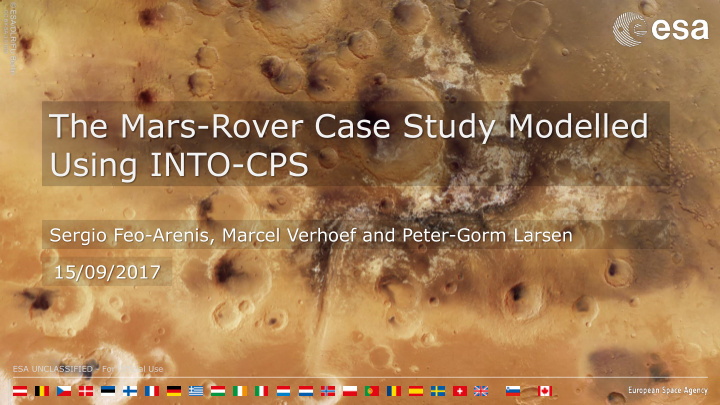



The Mars-Rover Case Study Modelled Using INTO-CPS Sergio Feo-Arenis, Marcel Verhoef and Peter-Gorm Larsen 15/09/2017 ESA UNCLASSIFIED - For Official Use
Goals of the Study Understand the effort required to migrate existing co-simulation models from • DESTECS into INTO-CPS. Explore the advantages and limitations of using INTO-CPS for co-simulation • workflows. In particular, the FMU/FMI paradigm. System or Mission-Level INTO-CPS Co-Model Co-Model DESTECS Co-Model ESA UNCLASSIFIED - For Official Use Sergio Feo-Arenis | 15/09/2017 | Slide 2
INTO-CPS ESA UNCLASSIFIED - For Official Use Sergio Feo-Arenis | 15/09/2017 | Slide 3
The Mars Rover Case Study Aim: to develop a co-model to evaluate controller strategies through simulation • Proprietary ESA Model of vehicle dynamics • Wish to evaluate different controller proposals without disclosing the model • ESA UNCLASSIFIED - For Official Use Sergio Feo-Arenis | 15/09/2017 | Slide 4
Co-Simulation Model Control strategies • Simplified geometry • Mode switching • Environment model • Safeguard mechanism • Contact model • F F Discrete Continuous- M Controller COE M Time Model Model U U VDM-RT 20-Sim ESA UNCLASSIFIED - For Official Use Sergio Feo-Arenis | 15/09/2017 | Slide 5
Overture FMI Extension Automatic inclusion of FMU library • Automatic import of model descriptions from Modelio • Requires modifying models: • 1. Add HardwareInterface class containing exchange ports, their types (bool, int, real and string) and exchange directions (input / output) 2. Adapt model to read and write from the hardware interface using dedicated methods Automatic generation of FMU • Tool wrapper • Source code • ESA UNCLASSIFIED - For Official Use Sergio Feo-Arenis | 15/09/2017 | Slide 6
Overture FMI Extension ESA UNCLASSIFIED - For Official Use Sergio Feo-Arenis | 15/09/2017 | Slide 7
Overture FMI Extension ESA UNCLASSIFIED - For Official Use Sergio Feo-Arenis | 15/09/2017 | Slide 8
20-Sim FMI Extension Declaration of external variables • specifying type and direction No need to use dedicated functions • for reading or writing Support code generation (20-Sim 4C) and • code-based FMU (experimental) Support tool wrapper FMU generation • ESA UNCLASSIFIED - For Official Use Sergio Feo-Arenis | 15/09/2017 | Slide 9
20-Sim Model ESA UNCLASSIFIED - For Official Use Sergio Feo-Arenis | 15/09/2017 | Slide 10
Results Performed model adaptation for FMI generation • Created an INTO-CPS co-model from generated FMUs • Effort required: • ~20 work hours for model modification: learning curve, addition of FMI- • specific constructs, configuration of the co-model, debugging Involvement of tool vendors for the resolution of issues with software • components (20-sim FMU generation, contact model update) Able to reproduce the simulation outcome of the INTO-CPS setup • ESA UNCLASSIFIED - For Official Use Sergio Feo-Arenis | 15/09/2017 | Slide 11
Results ESA UNCLASSIFIED - For Official Use Sergio Feo-Arenis | 15/09/2017 | Slide 12
Results ESA UNCLASSIFIED - For Official Use Sergio Feo-Arenis | 15/09/2017 | Slide 13
Challenges Encountered Model compatibility issues, update required for current tool versions • Interface definitions • VDM reserved keywords • Upgraded contact model • Experimental status of the tools involved. • No support for interrupt-like events in co-simulation mode. Requires • additional effort. No support for vector types. Requires either: • a. Encoding/Decoding via strings. b. Naming conventions plus additional tooling layer. ESA UNCLASSIFIED - For Official Use Sergio Feo-Arenis | 15/09/2017 | Slide 14
Advantages and Outlook Management of intellectual property • Possibility of distributed model construction • Possibility of distributed, heterogeneous simulation • Possibility of “system of systems” mission analysis • Possibility of early validation of on-board software • Currently working on code generation from discrete models • (vdm2c) Allow integration into co-models as well as deployment into • hardware targets using TASTE ESA UNCLASSIFIED - For Official Use Sergio Feo-Arenis | 15/09/2017 | Slide 15
Recommend
More recommend